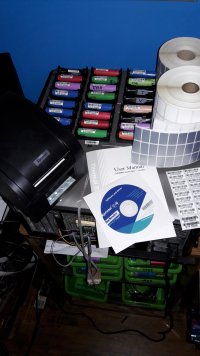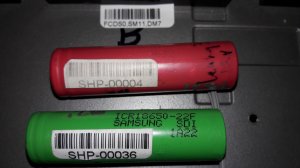SecondHandPower
Member
- Joined
- Dec 2, 2017
- Messages
- 79
I found a few cells with barcodes from the factory... none seem to beuseful to me, but I cant help thimking how much I want to sticka simple barcode label on my cells.
On the other hand the process of using a marker to write the mAH orvoltage (or time or temperature or date or whatever you feel is important ) is simple and easy to do and proven by the test masters with thousands of cells tested, and so far I have processed 3 cells all the way through.
On the way, i tested a few heaters and had several cells that charged really slow, but I cant tell which ones they were, or if those will have a decent mAh number to make the cut later on.
So I decided to see what I could do with barcodes for cheap, without making it a painto do data entry and I found a couple of apps that scan barcodes using my smartphone. I tested one app that scans into a spreadsheet (on my Android) and another that will open a web page when I scan a code, so I set the search URL to launch theDIY Powerwalls Cell Database with one tap.
However, when I get to the cell database, there is no searchbar for that page or the detailed content on the second page (where you can see the cell numbers and ratings)
I would like to look up cells using a barcode on a printed list of cells by model number that has all the specs in barcode format so I could associate the serial number to all the factory specs in my tracking spreadsheet with a couple of clicks (on my phone!)
There are barcode fonts for use in several apps, so it would be simple to create my own spreadsheet and the related barcoded information on a computer and then use that on the phone.
Anyone using barcodes andtracking spreadsheets etc ?
On the other hand the process of using a marker to write the mAH orvoltage (or time or temperature or date or whatever you feel is important ) is simple and easy to do and proven by the test masters with thousands of cells tested, and so far I have processed 3 cells all the way through.
On the way, i tested a few heaters and had several cells that charged really slow, but I cant tell which ones they were, or if those will have a decent mAh number to make the cut later on.
So I decided to see what I could do with barcodes for cheap, without making it a painto do data entry and I found a couple of apps that scan barcodes using my smartphone. I tested one app that scans into a spreadsheet (on my Android) and another that will open a web page when I scan a code, so I set the search URL to launch theDIY Powerwalls Cell Database with one tap.
However, when I get to the cell database, there is no searchbar for that page or the detailed content on the second page (where you can see the cell numbers and ratings)
I would like to look up cells using a barcode on a printed list of cells by model number that has all the specs in barcode format so I could associate the serial number to all the factory specs in my tracking spreadsheet with a couple of clicks (on my phone!)
There are barcode fonts for use in several apps, so it would be simple to create my own spreadsheet and the related barcoded information on a computer and then use that on the phone.
Anyone using barcodes andtracking spreadsheets etc ?








